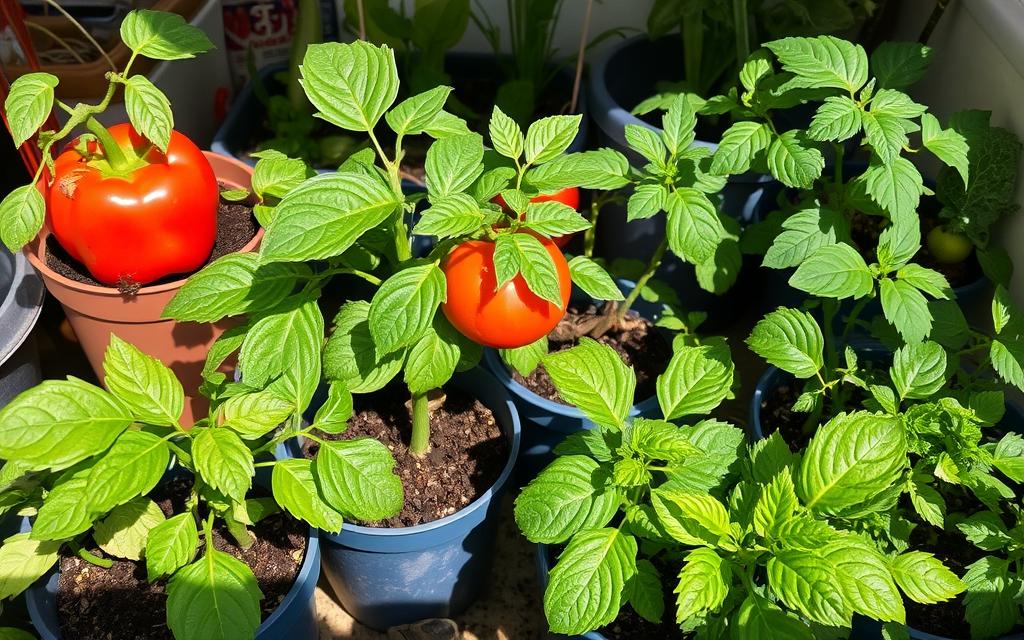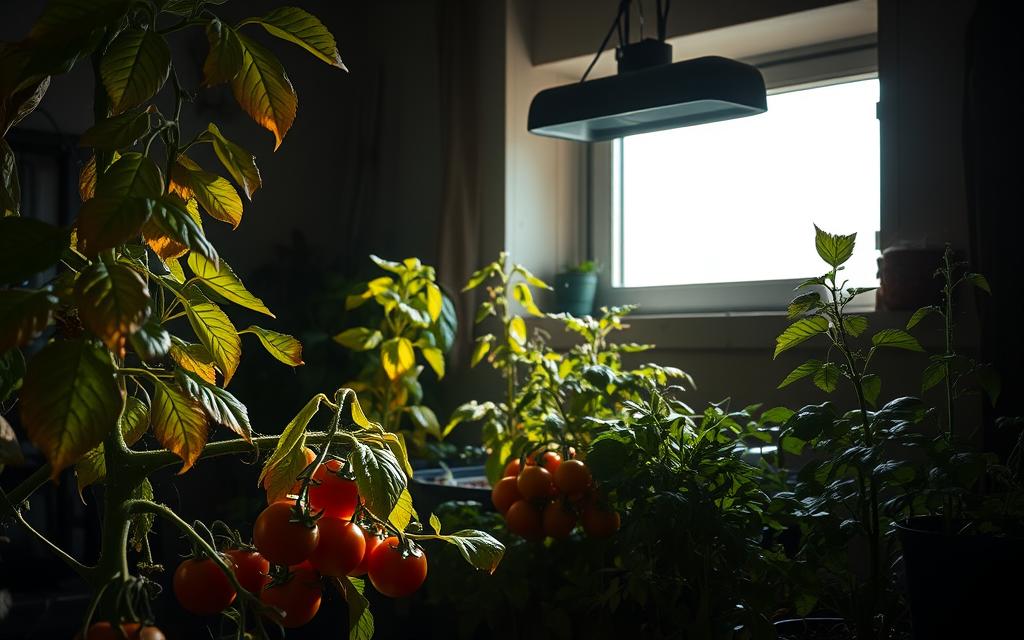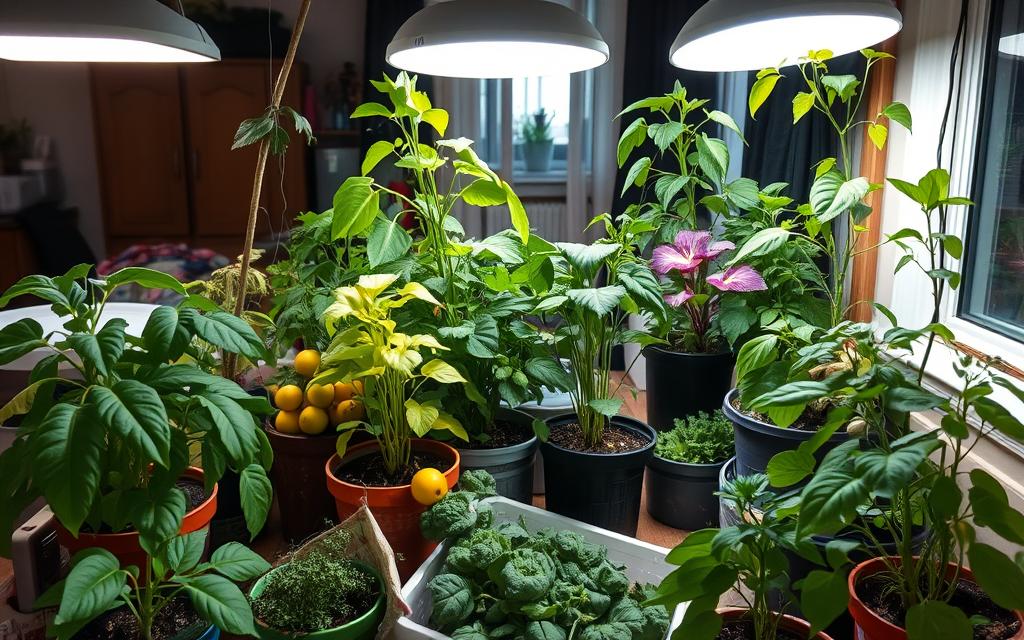Did you know over 85% of city apartment dwellers grow their own food indoors? But, it’s not easy. They face many challenges that can harm their plants. One big problem is not enough light. Plants need at least 10 to 12 hours of artificial light a day.
Temperature is also key. Summer veggies need it warm, around 80°F during the day and 65°F at night. Without the right temperature, fruits won’t grow well. Low humidity is another issue. Air conditioning and heating systems dry out the air, making it hard for plants to grow.
Without insects or wind, pollination is tough. Pests like aphids and whiteflies can also be a problem. These issues highlight the need to carefully solve indoor gardening problems.
Other common issues include watering too much or too little, using the wrong fertilizer, and overcrowding. But, with the right knowledge and care, like choosing the right fertilizer and ensuring good drainage, plants can do well indoors. For more tips on indoor gardening, check out this article on using vertical space in your garden.
Introduction to Indoor Gardening Challenges
Indoor gardening can be rewarding but comes with challenges. I’ve faced many common issues that affect my plants’ health. Things like not enough light and changing temperatures are big problems.
Knowing these challenges helps me find solutions. For example, different plants need different amounts of light. Using the right soil and watering correctly also helps plants thrive.

More people are growing their own food indoors. Issues like pests, humidity, and temperature control are key. By tackling these problems, I can grow more food and become a better gardener.
To learn more about indoor gardening, check out resources on overcoming indoor plant obstacles. This helps me keep improving and enjoy fresh produce all year.
| Common Issues | Solutions |
|---|---|
| Insufficient Light | Use LED grow lights or fluorescent shop lights to enhance light exposure. |
| Temperature Fluctuations | Maintain a steady temperature between 60°F to 70°F for optimal growth. |
| Pest Infestations | Apply natural treatments like neem oil or insecticidal soap for pest control. |
| Watering Issues | Implement proper moisture levels; consider distilled water for sensitivity. |
| Humidity Levels | Use a humidity gauge and introduce methods like misting to improve moisture. |
Insufficient Light: A Common Dilemma
Dealing with too little light is a big challenge in indoor gardening. Many plants need 10 to 12 hours of light a day to grow well. Leafy greens and some herbs can do okay with less light, but tomatoes and peppers need more.
Knowing how much light your plants need is key to growing food indoors.
Understanding Light Requirements
Every plant has its own light needs. Seedlings need 12 to 16 hours of bright light to grow strong. If they don’t get enough light, they become weak and floppy.
Getting enough light helps plants grow healthy and strong. This also lowers the chance of diseases and other problems.
Solutions for Low Light Conditions
Grow lights can help if you have too little natural light. These lights add to the sunlight your plants get. I suggest using full-spectrum LED or fluorescent lights, as they mimic sunlight well.
To get more light, rotate your plants and move them closer to the light as they grow.

Temperature: Striking the Right Balance
Temperature is key in indoor gardening. Knowing the best temperature ranges is vital for healthy indoor veggies. Most plants do well with daytime temps around 75°F (24°C) and cooler nights for growth.
Big temperature swings can slow growth and stress plants. This can hurt your harvest.
Optimal Temperature Ranges for Indoor Vegetables
Each plant likes different temperatures. For example, cannabis does best between 68°F to 77°F when it’s a seedling. In the vegetative phase, it prefers 71°F to 82°F. During flowering, it needs 68°F to 79°F.
Keeping these temperatures steady helps your plants grow well.
Managing Temperature Fluctuations
Using a mini greenhouse helps control temperature. It’s important to check the temperature often and make changes as needed. Good air flow in the grow room helps plants grow strong and healthy.
Looking into hydroponic gardening can help grow plants all year. It’s efficient and can be a great option for your indoor garden.
Humidity: The Overlooked Factor
Keeping the right humidity is key for indoor gardening success. Low humidity hurts plant growth and health. Indoor air often gets too dry from heating or air conditioning.
This makes it hard for plants to absorb water. Plants struggle to grow well in dry air. Knowing this helps fix indoor gardening problems.
Why Indoor Air Can Be Too Dry
The best humidity for plants is 50% to 70% during growth. For flowering plants, it’s 50% to 60%. Before I checked humidity, my plants grew slowly and wilted.
Cool season crops like lettuce and herbs like lower humidity. Warmer season crops need more moisture. As temperatures go up, plants lose more water, making the air more humid.
Techniques to Increase Humidity
To keep humidity right, I mist plants and use a humidifier. Misting adds moisture quickly. A humidifier keeps the air moist, helping plants thrive.
Good ventilation is also key. It brings in carbon dioxide and takes out too much humidity. This balance stops plants from getting too wet, which can cause fungus.
Try these humidity control methods to improve your gardening. They help plants stay healthy and produce better food.
Learn more about growing potatoesindoors
Pollination: Ensuring Fruit Production
Pollination is key for growing fruit indoors. It’s different from outdoor pollination. Indoor spaces lack natural pollinators like bees.
How Indoor Pollination Differs from Outdoor
Some fruits, like apples and pears, need two types to pollinate. Cherries also need bees for good fruit. But, fruits like raspberries can grow without bees.
Raspberries need 75 to 85 out of 100 to 125 pistils to pollinate. This shows how important pollination is indoors.
Methods to Aid Pollination Indoors
Indoors, I help pollinate plants myself. Shaking plants gently can help spread pollen. For extra help, I use hand-pollination.
These steps help with growing fruits like tomatoes and cucumbers indoors.
Keeping plants hydrated and using fans helps too. It makes the indoor garden healthier. This way, plants can grow well and produce lots of fruit.
For more tips on indoor gardening, check out bioluminescent plants. They add beauty and light to your garden.
Growing Edibles Indoors Problems: Watering Issues
Watering is a big challenge for indoor gardeners. It affects how well plants grow. Finding the right balance is key to keep plants healthy. I’ve learned that letting the soil dry a bit before watering helps manage moisture well.
Overwatering vs. Underwatering
Both too much and too little water can harm indoor veggies. Over 65% of seedlings struggle with too much water, not too little. Too much water cuts off oxygen in the soil, causing root rot. On the other hand, not enough water makes plants wilt and weakens them.
Knowing these issues helps solve problems in indoor gardening. It’s important to understand these challenges to grow plants well.
Best Practices for Watering Indoor Vegetables
To keep my indoor veggies healthy, I follow some key steps:
- Water them at the same time every day, based on their needs.
- Use soil that drains well to avoid waterlogging.
- Don’t let plants sit in water for too long.
- Check the soil moisture often and adjust watering as needed.
Using these methods helps my plants grow well. It makes gardening indoors more fun and rewarding.
Nutrient Management: Fertilizer Challenges
Nutrient management is key to growing edibles indoors. Knowing what each plant needs is important to avoid mistakes. I watch how different fertilizers affect my plants closely. The wrong fertilizer can slow growth.
Using the wrong amount can cause problems like blossom-end-rot in tomatoes. This issue comes from not balancing nutrients right. By following tips for growing edibles indoors, I help my plants grow better.
Common Fertilization Mistakes
Many gardeners struggle with nutrient management. Some common mistakes include:
- Applying too much fertilizer, leading to nutrient burn.
- Neglecting to replace nutrient solutions regularly, which can cause salt build-up.
- Using a single type of fertilizer for all plants, ignoring specific nutrient needs.
Getting fertilization right is important for plant health. I watch my plants closely and adjust fertilization as needed. This ensures they get the right amount of nutrients.
Choosing the Right Fertilizer for Edibles
Choosing the right fertilizer is critical for growth. Important factors include:
| Fertilizer Type | Nutrient Ratio | Application Frequency |
|---|---|---|
| Liquid Fertilizers | High Nitrogen (N), balanced P, K | Every two weeks |
| Granular Fertilizers | Slow-release | Every month |
| Organic Fertilizers | Compost-based | Every six weeks |
By following these tips, I can grow better and healthier plants indoors. I check nutrient levels to make precise adjustments. This helps my garden thrive.
Pests and Diseases: Indoor Threats
Indoor gardening is a joy, but it comes with challenges. Pests and diseases can harm my plants. Knowing how to spot and manage these problems is essential.
Identifying Common Indoor Pests
Many pests can invade indoor gardens. Aphids harm plants like ivy and hibiscus, causing them to grow abnormally. Mealybugs hide on cacti and succulents, leading to stunted growth and early leaf drop.
Soft scales attach to stems of plants like ficus and citrus. Whiteflies cluster on leaves, causing them to turn yellow and weaken. Thrips create streaks on flowers, mainly affecting those grown in greenhouses.
Spider mites thrive in dry air, causing stippling and webbing on leaves. Fungus gnats, while not directly harmful, indicate overwatering and can harm root growth.
Preventative Measures for Healthy Plants
To keep my indoor garden healthy, I take proactive steps. Regular checks help me catch pests early. Keeping the growing area clean helps prevent infestations.
I use insecticidal soaps and organic pesticides to control pests safely. Introducing beneficial insects, like ladybugs, helps keep pest numbers in check. Good air circulation and avoiding too much water prevent diseases like powdery mildew and root rot.
Overcrowding: Space Management for Indoor Gardens
Managing space well in an indoor garden is key for healthy plant growth. Overcrowding can harm plant health and reduce yields. Giving plants enough space helps with air flow, light, and resource sharing.
Knowing how to place plants is vital for a thriving garden. It makes the most of small spaces.
Understanding Plant Spacing Needs
Each plant type needs different space based on its size and growth. Most veggies need 6 hours of sunlight daily. Fruit plants like tomatoes need 8 hours.
To meet these needs, I divide my garden into sections. Proper spacing prevents stunted growth and pest issues. Here’s a table showing typical spacing for veggies:
| Vegetable | Row Spacing (inches) | Plant Spacing (inches) |
|---|---|---|
| Tomatoes | 24-36 | 24 |
| Peppers | 18-24 | 18 |
| Lettuce | 12-18 | 6-12 |
| Radishes | 12 | 2-4 |
| Basil | 12-18 | 12 |
| Parsley | 12 | 6-12 |
Creating an Efficient Indoor Garden Layout
To boost productivity, I use square-foot and vertical gardening. These methods save space and improve light for plants. Choosing compact varieties fits more plants in small areas.
I prefer terracotta pots for their aeration and temperature control. Keeping an eye on spacing helps manage water and nutrients. This ensures the best taste and quality of veggies. For more on spacing, check out spacing techniques for indoor gardening success.
Conclusion
Growing edibles indoors can be tough, but it’s also rewarding. I’ve learned that knowing about lighting, temperature, and humidity is key. Using the right techniques and new tech has boosted my garden’s success.
LED lights and automation have helped a lot. They’ve improved plant health and growth.
There are many options, like microgreens that grow fast and exotic plants from local nurseries. Even though some exotic plants take longer, the wait is worth it for a big harvest. Places like Fairbanks’ Holm Town Nursery and Mile 5.2 Greenhouse in Eagle River have a wide range of plants.
Dealing with pests, like spider mites, requires constant watchfulness and prevention. I suggest trying different things and learning from others. With these tips, anyone can grow a successful indoor garden with fresh, homegrown food.
FAQ
What are the common challenges faced when growing edibles indoors?
Challenges include not enough light, temperature changes, and low humidity. Also, poor pollination, watering mistakes, wrong fertilization, pests, diseases, and not enough space are common issues.
How can I provide adequate light for my indoor vegetables?
Many plants need 10 to 12 hours of light daily. Grow lights can help if natural sunlight is lacking. This ensures your plants get the light they need to grow well.
What temperature is best for growing indoor edibles?
Most plants like temperatures around 75°F (24°C) during the day. At night, they prefer it a bit cooler. Keeping temperatures steady helps your plants stay healthy.
What can I do if my indoor air is too dry?
To add humidity, try misting your plants or using a humidifier. You can also place water trays near them. This creates a better environment for growth.
How can I ensure successful pollination indoors?
For self-pollinating plants, gently shake them or use a fan to spread pollen. For plants needing insect pollination, hand pollination works well to ensure fruiting.
What are the signs of overwatering or underwatering my indoor plants?
Overwatering causes yellow leaves and root rot. Underwatering leads to wilting and dry leaves. Let the soil dry a bit before watering to keep moisture right.
How do I choose the right fertilizer for my indoor vegetables?
Find out what each plant needs and follow the fertilizer instructions. Using the correct type and amount is key to avoid mistakes.
What should I do if I notice pests on my indoor plants?
Check your plants often for pests like aphids or whiteflies. Treat them quickly with organic pesticides. Keep your growing area clean to stop infestations.
How can I prevent overcrowding in my indoor garden?
Plan your garden layout with each plant’s mature size in mind. Give them enough space for sunlight and air. This helps them grow healthier.
Source Links
- Indoor Edible Problems – Issues With Growing Veggies Inside
- Growing Vegetables Indoors: What Temperature?
- Growing Vegetables Indoors Over the Winter: Not So Simple!
- Indoor Gardening for Beginners: An Ultimate Guide
- 7 Tips For Creating And Maintaining An Indoor Edible Garden
- How to Grow Vegetables Indoors (Easy Beginner’s Guide)
- Soil decision dilemma
- 8 Common Mistakes to Avoid When Starting Seeds Indoors
- Growing Seedlings Indoors: What’s the Problem? – Countryside
- 6 Pro Tips for Perfect Grow Room Climate Control
- Temp, Humidity & Light. Factors That Impact Cannabis Plants
- The Ultimate CO2 Guide for Indoor Growing
- Temperature and Humidity
- Cannabis and Heat Stress: How to Identify and Solve Problems
- Smart Gardening: Pollination in vegetable gardens and backyard fruit
- How To Pollinate Plants Indoors
- Edible Gardening
- Prevent Indoor Seed Starting Problems Before They Start – The Beginner’s Garden
- 5 Common Indoor Gardening Challenges and Their Solutions
- No title found
- Principles of Nutrient and Water Management for Indoor Agriculture
- Pest and Disease Problems of Indoor Plants
- Diagnosing Houseplant Problems Caused by Insect Pests
- How to Grow Vegetables Indoors: Complete Guide – Urban Turnip
- Container Gardening : Growing Vegetables in Limited Spaces
- Indoor Edible Gardening
- What Are the Best Edible Plants You Can Grow Indoors?
- How Edible Garden thrives inside with CEA greens growing – Organic Grower







